| O Ce Biel |
| From the Friulan song "O Ce Biel Cjiscjel a Udin" |
| Memories of 1970s Friuli |
|
|
| HomeArrivalBrandoGowanTalmassonsTerremoto |
| ReturnFoodPoemsSongsVeniceTriesteUdineseMerlot |
Return |
In July 2002, I went back to Friuli on a visit to celebrate my 50th birthday, nearly 27 years after when I first arrived there. Charles came with me. He'd been living in Bristol for some years, only forty minutes from my home in Gloucestershire, and we'd seen each other often. It seemed like a good scam to have someone along who had experienced those years; as it turned out, he was the perfect companion for such a flight of nostalgia. Thursday 25th July 2002 Charles picked me up from my house early in the morning. We had to get to Stansted for a late morning RyanAir flight to Ronchi, the airport that serves Udine and Trieste. We landed at Ronchi on time and Chris was there to meet us. White-haired now, but looking very well, the same chipper Yorkshireman with the quick, busy stride. While many of us returned to the UK or moved on to other countries after the 70s, Chris remained in Udine, married Daniela and settled down. Daniela has a son from a previous marriage called Riccardo and they have a daughter called Stephanie, who was just about to go to the University of Padova in 2002. [This needs updating in 2022, the time of my latest edit. Daniela is retired, Stephanie is married to Paul and living in Blackheath, working for Facebook. Riccardo is married to Silvia and has two children, Tommaso and Pietro. He was in Hong Kong for five years, working for Wells Fargo. He has now returned to Friuli and is running his father-in-law's company in Mortegliano.] Chris stayed in English language teaching and was a professor at Trieste University in the field of English Language and Translation, recently retired. "OK, beer, Chris", we said, and took off to nearby Palmanova, a small town south of Udine, an example of a star fort of the late Renaissance. Built in the shape of a nonagon, six of the main "spoke" roads lead directly to the very large central square. We sat outside a bar on the broad pavement that curves around the perimeter of the square (actually it's nearly round, a 6-sided polygon), and had our first chilled "Birra Moretti", "all spina" - draught, pulled from a gaudy set of taps. 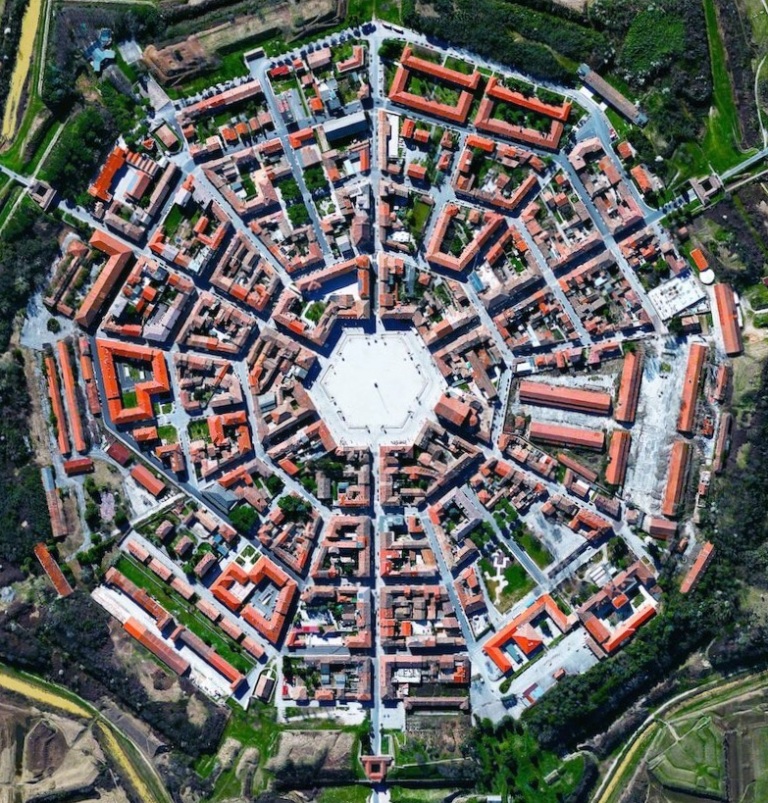 We set off to Udine. Chris had to attend to some errands, so we said we'd go for a stroll and make our own way back to his house. He dropped us near the station and our renewed love affair with the city began. The anticipation was just as it had always been. It was still early, maybe 4 o'clock. The air was warm, the buildings glowed in the afternoon sunshine. The city was waking up after the midday closedown. Just like all those years ago, we weren't in a rush. We strolled slowly into the centre, arriving at Piazza della Libertą just below the Castello. 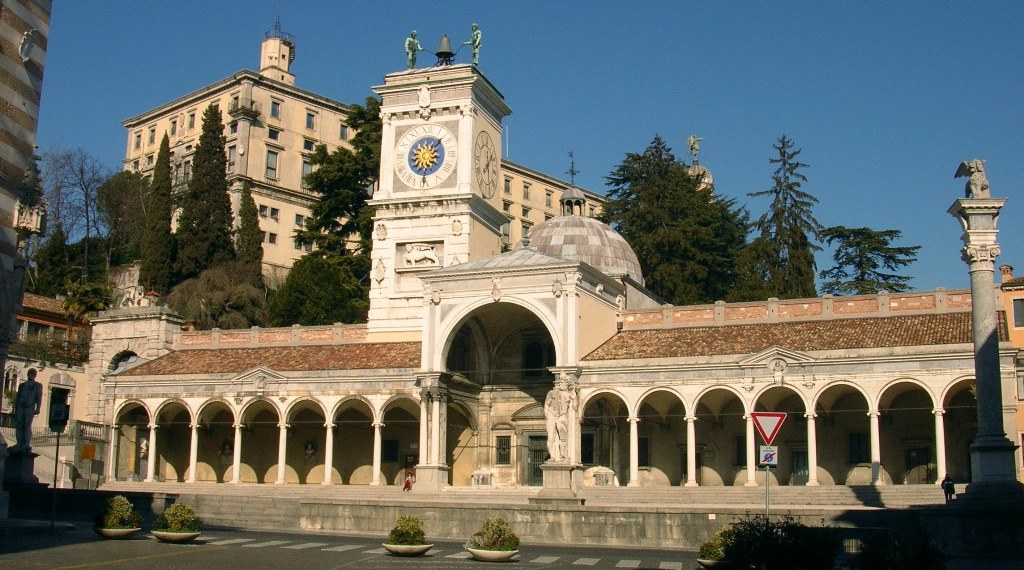 The castle and its grounds closed after the 1976 earthquake and I hadn’t been up there since. From outside the tobacconist on the south-east corner of the square, we crossed the road, the broad smooth marble pavements at the edge and the white gravel of the centre to the castle entrance tucked into the corner opposite. We walked up the curving cobbled road to the flat ground in front of the castle. 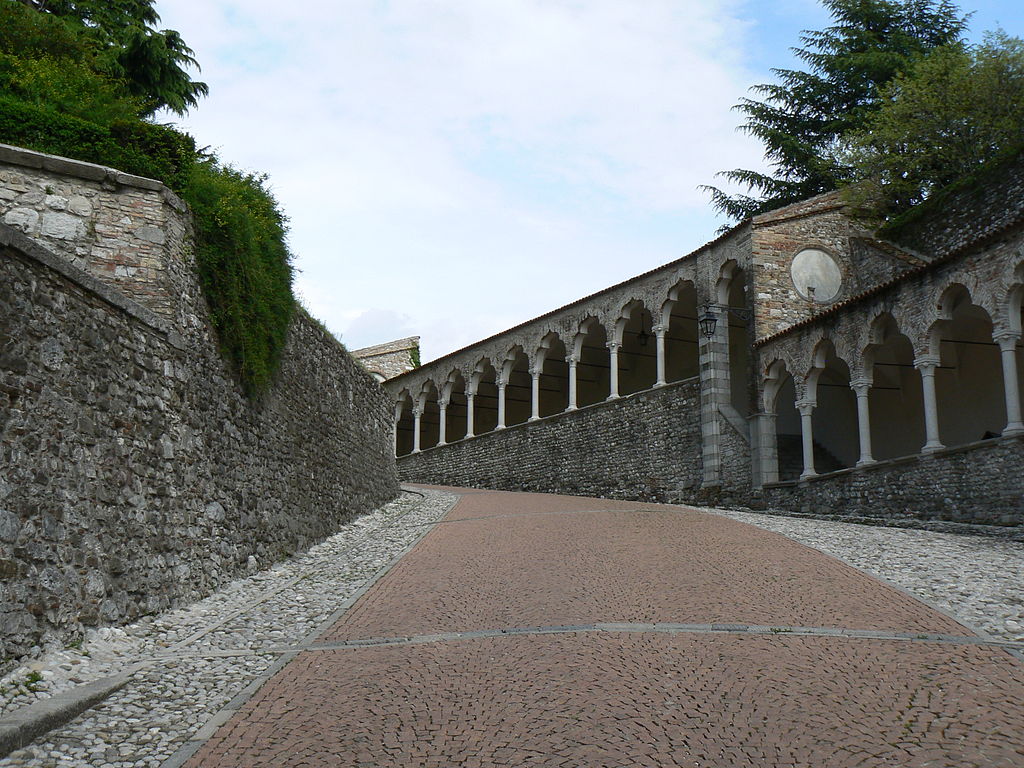 This road up is pretty but the castle really isn’t. This is at odds with the song on which the title of these memoirs is based: “O Ce Biel Cjiscjel a Udin” – “O Beautiful Castle at Udine”. Was it beautiful in a previous incarnation, the ruined fortress mentioned below? There is a legend about its origin saying that when Attila the Hun plundered Aquileia to the south of Udine in the year 452, he asked his soldiers to build a hill to see Aquileia burning; this was made by filling the helmet of each soldier with earth. The present building was built on the ruins of a fortress destroyed in the 1511 Idrija earthquake. The construction started in 1517 and lasted for 50 years. The external decoration is credited to Giovanni da Udine, one of the pupils of Raphael. See, it’s a palace, not a castle, right? The green in front was one of the few open spaces in Udine. In those early days we English played cricket up there. It affords a view of the city spread out below and the mountains to the north, snow-capped most of the year. Those mountains, visible on a clear day, had a strong pull. Skiing! We started going almost as soon as we arrived, most weekends in winter. An early trip was to Sappada, a small resort in the Carnic Alps, the Dolomites. We were absolute beginners and yet ventured down slopes well beyond our capability, mostly on our backsides, often deep in the trees bordering the piste. I took my visiting friends Guy and Ian up there one weekend. Ian was disabled in a motorcycle accident in 1970, walking with crutches, but he was determined to get to the top of the mountain. We went up in individual chair lifts, Ian riding in the one behind mine. As we approached the top and it became obvious that the chair lift did not stop to release its passengers (you were expected to ski off), Ian let me know quite clearly that this was going to be a problem. Somehow I managed to attract the attention of the lift attendant and requested an unscheduled stop. 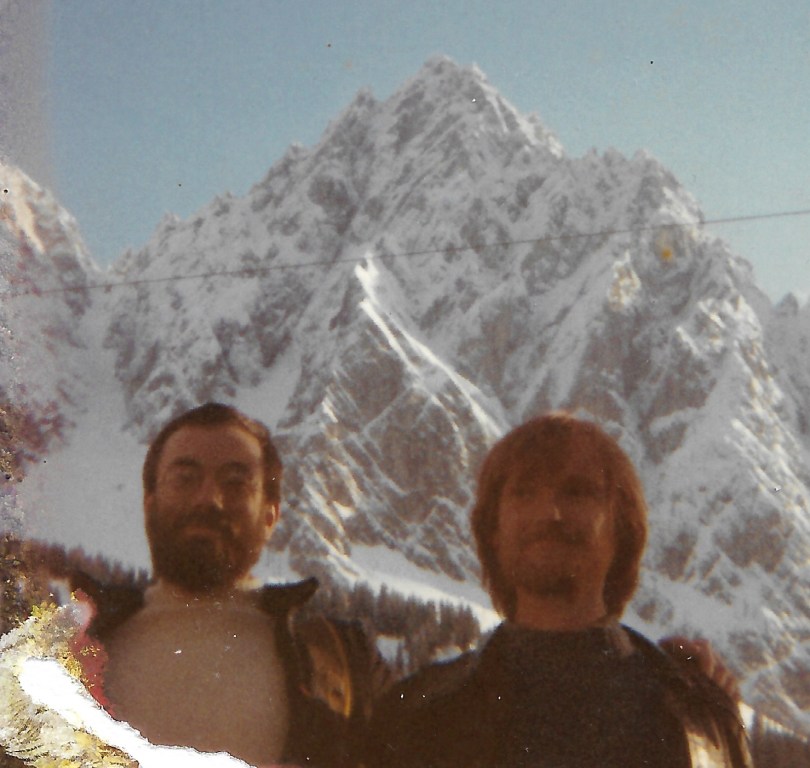
This weekend also gave rise to a term we have used to the present day. The bus – we had no cars then – to Sappada goes through Tolmezzo. For some reason (Chris has kindly pointed this out) I've confused Tolmezzo with Tarvisio, possibly because we took that bus to go to Sella Nevea, another ski centre. For the sake of the punchline, I'll stick with Tarvisio for this episode. The driver had a strange tendency to lift his foot off the accelerator at repeated and quite predictable intervals. This pitched you forward gently in your seat. If you wanted to sleep after the usual early morning start, you simply couldn’t, rhythmically awakened. The syndrome was christened “Tarvisio Bus Driver’s Foot”. Back to Udine and the castle. Charles and I continued our stroll around town. We went to the bar next to the old school in Via Paoli Sarpi, then the Grappolo D’Oro, scene of many evening get-togethers after class. We must have unconsciously been heading for Da Brando because we stopped at Al Marinaio in the lovely old Via Grazzano – of ill-repute in 1975, home to the ladies of the street - that leads to Piazzale Cella. Outside Al Marinaio, I recognised a local, a man I must have seen in the same place in 1975. I was a little startled; he looked about 60. I realised that I had last seen him 27 years earlier when he would have been in his early-30s. This triggered the thought: “What’s changed?” Not much. The city looked the same, the streets and buildings. Maybe Via Grazzano was a bit gentrified. The bars and restaurants were still there. The names were the same. Why should they change? They were right in the first place. On our return, familiar and comfortable. After a few hours of this re-introduction to the mood, style and customs of Udine, Charles and I turned to another question. We felt there was an overriding quality about the place and the people but it took us time to come up with the right word. It had nothing to do with the common Italian stereotypes and surprised us. Discipline. I hope I’m not creating another stereotype here but the impression was compelling. Italians, or those I know in the north-east, have a great sense of order in their lives. We all know about the dress sense. Historical city centres are treasured and maintained. Food follows rules and traditions. Wine is considered in detail, everybody knows the stages of the production process and it’s treated with respect and passion. The early evening “passeggiata” with “aperitivo” is a time-honoured custom. We eventually made it to Piazzale Cella to Da Pozzo and Da Brando. My notes tell me that we met Carla and Fulvio a couple of times on this trip, but not on which day. I don’t remember and it doesn’t matter.   What I do recall is a conversation with Carla in Pozzo’s. Standing at the bar, I was overcome by a very strong sensation, an intense body surge. “Carla, do you know what?” “Err … no, Charlie … what?” “This may sound weird, but … I feel like I was born here.” “Tell me more.” “It’s a sense of familiarity, comfort, understanding, ease. I feel like I belong.” “Well … you do.” Fortified by tour and “taillut” (the Friulan for a small glass of wine) we returned to Chris’ house where he and Daniela cooked us a delicious barbecue. Friday 26th July 2002 We took the little train to Cividale.  It’s a journey of just over 17 kilometres, a branch line heading due east over the last stretch of the plain, foothills and mountains visible to the north, passing through maize fields and light industrial outposts. Cividale del Friuli is a jewel. It has history, back to the Celts, its foundation as a Roman “municipium”, the first major centre of the Lombard kingdom, annexation to the republic of Venice, finally joining Italy in 1866. The old centre is calm, elegant, mostly pedestrian. It’s a gateway, with that promise of the east that I’ve mentioned in the “Gowan” section. The border with Slovenia is only 20 minutes’ drive up the valley of the enchanting river Natisone. In 1975/6 we used to make a Saturday trip into the then Yugoslavia to get petrol and meat at half the usual Udine prices. 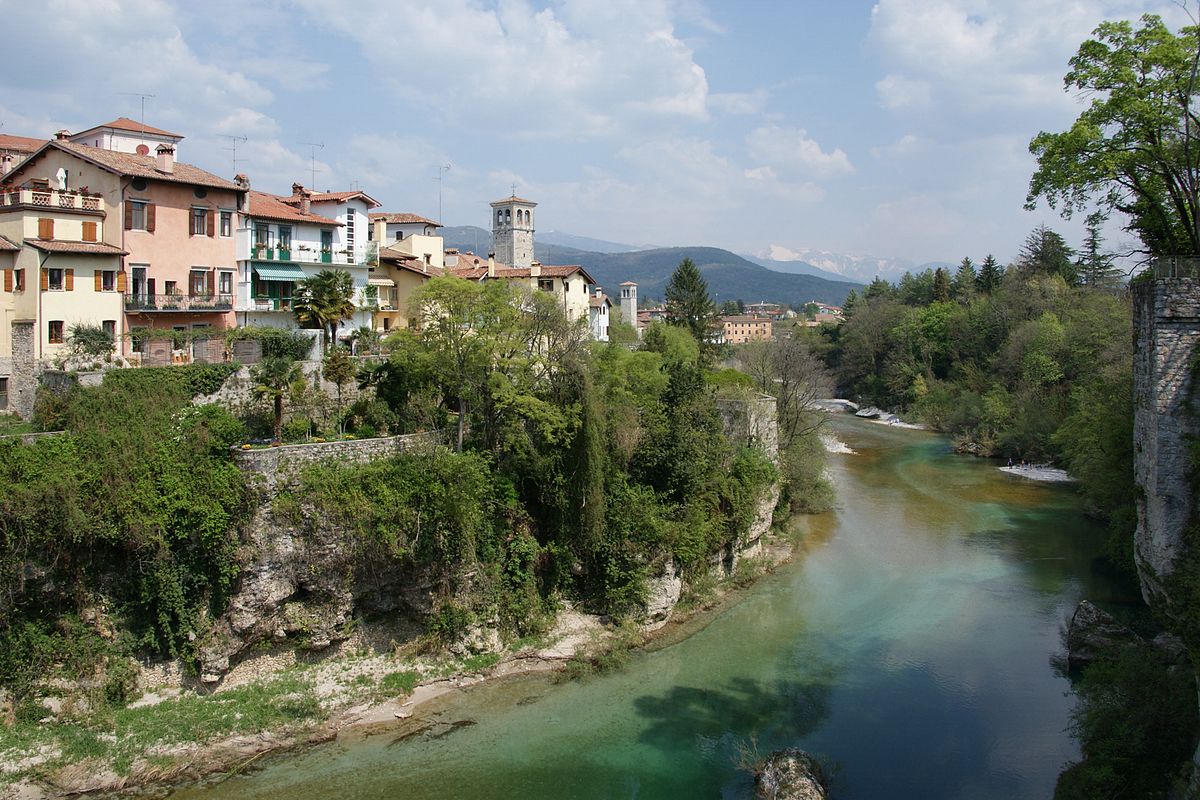 We roamed around those hills you can see in the distance, often walking miles up the "strade bianche", white-gravel country roads. Gowan had made a friend called Sandrin in Oblizza, high up close to the border. On returning from one visit, we had a strange experience in a village roadside “osteria” lower down the mountain. I think the village was Stregna, but I can’t be sure. It was quiet inside, mid-afternoon, certainly no more than ten customers. We ordered glasses of wine and sat at one end of the main front room. The sequence of events that unfolded will stretch you the reader’s credulity, but I can swear that it’s all true. There was a drum kit set up in the adjoining room, accessed through open double doors. A young lad, probably the owner’s son, sat down at the drums and started to hammer away on them. Deafening. Nobody could hear themselves speak any more. Chris remembers a boy with an accordion who added to the merriment. Shortly afterwards, perhaps in sympathy, the man at the next table began to batter it with his fist, a heavy violent motion. His glass of red wine would leap at each impact and travelled inexorably across the table. As the glass approached the edge the barman would come round and reposition it in the middle. Absolutely no comment from him or the locals. Standing at the bar was a man who appeared to be lightly covered in coal dust. From time to time he would reach inside his coat and pull out a package. It was the size of a small brick, wrapped in paper or cloth. Then he put it away, repeating the action a few minutes’ later. He never opened it and we never saw the contents. He stopped after a while and turned his back on the bar. Gradually he appeared not to be able to stand up straight, leaning back ever more sharply so that he had to rest his head and shoulders on the counter top. This lasted for ten minutes until two friends rescued him. One on each side, they half-carried him out of the front entrance. When we left later he was still outside, stretched backwards in the same position across the bonnet of a car. We named his condition “Malattia di Vino”, wine sickness. Back to 2002. We wanted to go up the Natisone valley. It's so special, deepening as you get closer to the border, wooded hills to left and right, the limpid river glimpsed when the road draws near, small hamlets beckoning from side road signs. Place names that simply aren't Italian: Stupizza, Brischis, Lacis, Spagnut, Tuomaz. We're in a different country here. We caught the bus to Pulfero, about 13 kilometres towards the border. “God’s Own Country” Gowan had said and he was right. I love Italian buses, not so much those in towns but the “corriere” that run between them. In fact, I love most forms of public transport; don’t get me started on my recent experience of the magnificent Vienna tram system. Anyway, our bus was a classic blue-grey “pullman” with battered leather seats and a throaty rear engine. The driver was typical of his profession, immaculate in dark blue razor-creased trousers and a pale blue perfectly-ironed shirt, with a thick head of hair gone prematurely a distinguished grey. We also had the requisite chance encounter with a fellow passenger, a middle-aged woman who had lived in Wrexham and attended the 1986 Edinburgh Commonwealth Games. Now travelling up the Natisone valley, right? In Pulfero we had lunch at the Albergo al Vescovo.  Like the Birra Moretti man, it doesn’t look Italian, does it? It’s not the greatest restaurant but it’s one of my favourites. We dined on the terrace behind in dappled sunshine right by the chuckling Natisone, with the wooded hillside beyond. I remember venison and a cranberry sauce. On a visit with Gowan’s family years before, we had asked the owner’s permission to place a table and chairs in the river, a few steps down from the terrace. We sat in our rolled-up trousers sipping white wine. It's now July 2020. Fran Hall has just sent me two pictures of the drinks in the river. In the first I can just make out Gowan, Andrew, Mick, me and Carolyn. I'm the drinks waiter in the second. That day, I swear we thought we were immortal. 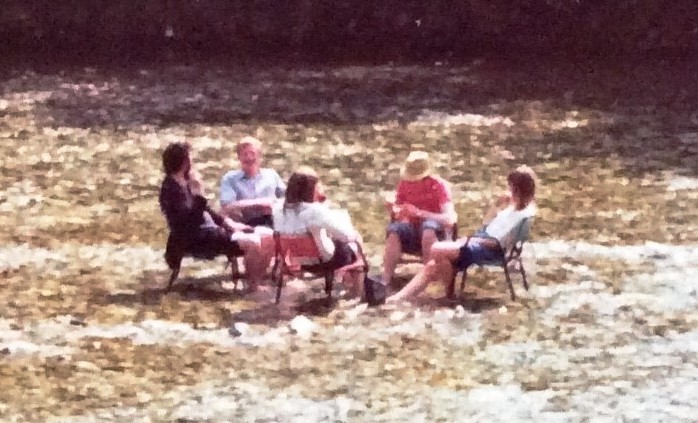

Back to 2002. Charles and I caught the return bus to Cividale mid-afternoon. A leisurely stroll through the old streets to the Ponte del Diavolo. 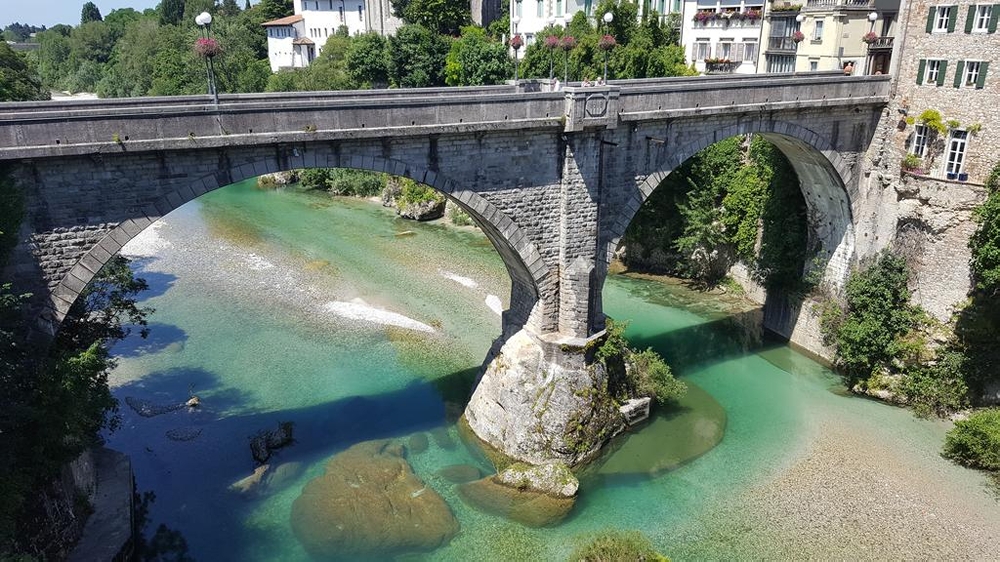 We paddled in that cool clear water and had a snooze on one of the dried-out banks. Then back on the little train to Udine and out to dinner with Chris and Daniela, I think in the village of Nimis. I’ll have to check with Chris. Saturday 27th July 2002 Artegna. We caught the “locale” from Udine railway station. It was stiflingly hot, so I ignored all the warnings that I mentioned at the top of the “Arrival” section. "E’ pericoloso sporgersi". "Ne pas se pencher au dehors". "Nicht hinauslehnen". Well, I did. I had my head out of the door window for most of the journey, cooling myself in the stiff air current. We walked into the centre, which is some way from the station. 26+ years on from the May 1976 earthquake. No evidence of that event, at least not to the visiting eye. I’m sure the people of Artegna have all kinds of reminders of the tragedy. To me, it was all very neat and orderly. No visits to old friends this time, but we did spot Gustin waiting in the main square. He was collected by some men sporting the headgear of the Alpini, an elite infantry corps of the Italian army specialising in mountain warfare. The “Cappello Alpino” is distinctive and worn with great pride:  I assume they were all going off to a reunion. Gustin looked trim and well 26 years on, no doubt partly due to having renounced booze the day after the earthquake. There’s not a great deal more to be said that isn’t already in the “Terremoto” section. Artegna was back on its feet, looking prosperous if less quaint. After a drink outside a rather modern and soulless bar, certainly no snug “osteria”, we went up to the church above the square, paid our respects to the fallen of 1976 in the graveyard, took in the view and walked back to the station. We’d got all the train times muddled so had to wait an hour. I read a book. Charles rolled back time by stretching out on the platform for a “doss”. In those years we grabbed some shuteye in remarkable places. I recall a picture of Chris "dossing" on a piece of 2000-year-old stone in the Roman Forum. Once I took the last train from Venice to Udine (and beyond). I climbed into the luggage rack to get some rest. I slept through the Udine stop and was awakened by a guard at the Austrian border, poking me with his rifle. I had to wait through the small hours for the milk train back to Udine. Sunday 28th July 2002 Talmassons day. See the section on the village for details. It was also time to say goodbye to Chris and Daniela as we were going on to Trieste to catch our ‘plane home on Monday. We thanked them at the time, but here’s a chance to re-iterate our gratitude. They looked after us beautifully, making this return trip so easy. Carletto picked us up from Udine station. We had lunch with his family, including daughter Lucia and her husband, and then went off to visit old friends: Ermanno and Pierina, Chiara, two teachers whose names I sadly forget. A generous welcome everywhere. We went out through the fields to the enchanting church of Sant’ Antonio. 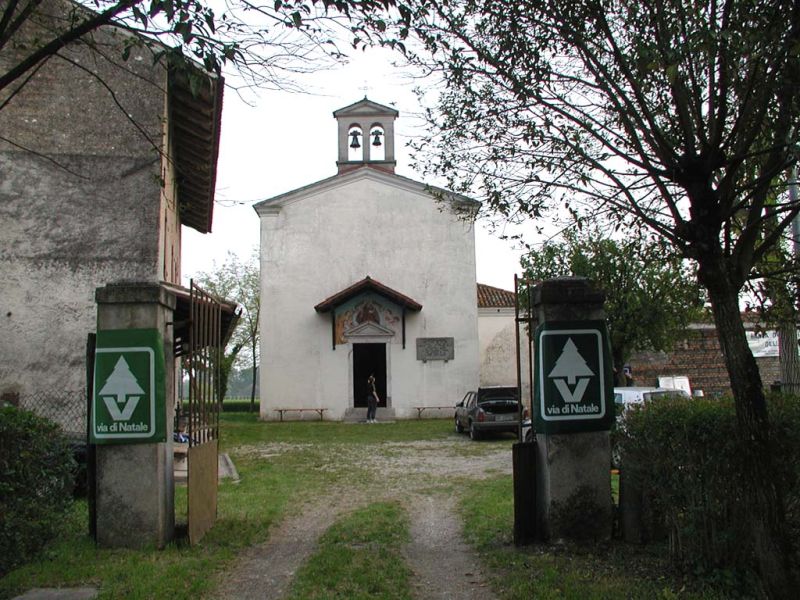 When I first went there, a slightly unkempt man lived in the house you see on the left, deemed a hermit by the locals. He tended the church and the surrounding plot. Carletto said that they would take us to Trieste. Never mind that it's an hour’s drive each way – that don’t-question-me generosity again. We went down the “Napoleonica”, which passes just north of Talmassons, a road of Roman and medięval origins updated by the emperor for troop movements in the war against the Austrian Empire. It was roaring hot. The beach by the coast road entering Trieste was packed. Trieste is a grand city. It was one of the oldest parts of the Hapsburg monarchy, the fourth largest city of the Austro-Hungarian Empire, after Vienna, Budapest, and Prague. Positioned at the edge of Italy, it has changed allegiance periodically. There is an international feel. Interesting people from other countries have lived there. James Joyce was a resident between 1904 and 1920, writing most of Ulysses and A Portrait of the Artist as a Young Man. In 1876 Sigmund Freud worked in the Institute of Comparative Anatomy and received a research scholarship to work at the Laboratory for Marine Zoology. He studied the sexual organs of eels. Sir Richard Francis Burton (explorer, geographer, translator, writer, soldier, orientalist, cartographer, ethnologist, spy, linguist, poet, fencer - you name it) finished his diplomatic career in Trieste, dying on 20th October 1890 of a heart attack. There have been ugly times, particularly in the Fascist era, with the appalling treatment of Slovenes and Jews. I remember a strong rivalry between Udine and Trieste. Udinesi mocked Triestini. Chris, in exalted company, has worked there for the largest part of his professional life - in his words, "I have now completed thirty-six years of commuting courtesy of Trenitalia" - so I've asked him to write his story of the city. See the "Trieste" section. The main square, Piazza Unitą d'Italia, is impressive. In one direction you see the fine buildings, in the other the square is open to the sea, all that maritime promise. 
Carletto
took us to
one of the smart bars on the square. Sitting in comfortable chairs
outside, warmed by the afternoon sun. Immaculate waiters, white shirts,
ties, dark aprons. Cool half-litres of beer. Typical of Carletto, ever
proud of his homeland; he wanted to show off the region, expressing his
own pride and pleasure.  Carletto and Bianca left around 6pm. We checked into a modest pensione for the night, had a fish dinner in a side street off the main square, dabbled with a German-styled bar and went to bed. Monday 29th July 2002 Our flight home wasn’t until early afternoon so we had time to do a bit more of Trieste. We went up to the cathedral of San Giusto, which stands on the hill of the same name in the heart of the ancient Roman city of Tergeste. A “doss” on warm stone benches. Great view of city and port:  Back in town, I went shopping for family. I bought an acorn-fed wild boar salame in a delicatessen rich-smelling with cured meats, mature cheeses and fresh herbs. Heaven. Then off to the airport and home. The flight went smoothly, made entertaining by a south-sea-islander rugby team returning from tour. Stansted and the drive home were fortunately bearable, unlike my summer 2018 experience of flying to Corsica when we encountered a Ryanair meltdown and an M25 car park. We must have chosen the route to Gloucestershire via Oxford and Burford because we stopped at the Sherborne Arms in Aldsworth for a delicious pint of ale in the sunny garden. 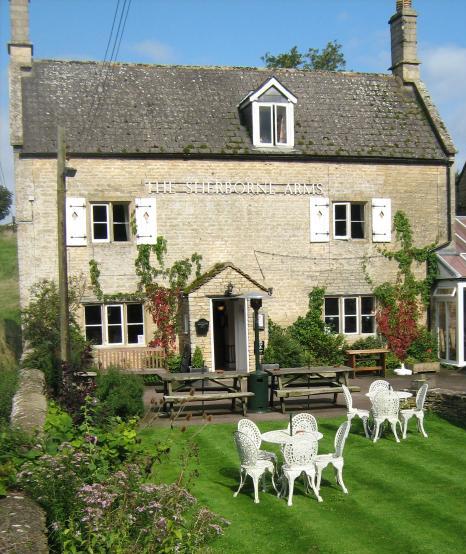 A charming soft landing after our trip. Not quite Friuli, but a Cotswold mini-classic, sought-after by many making the journey to our country. |

